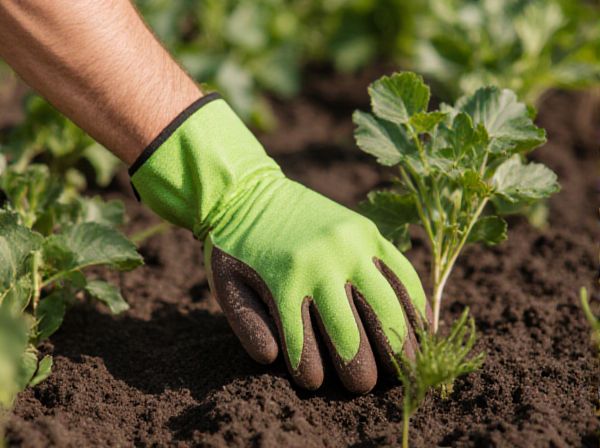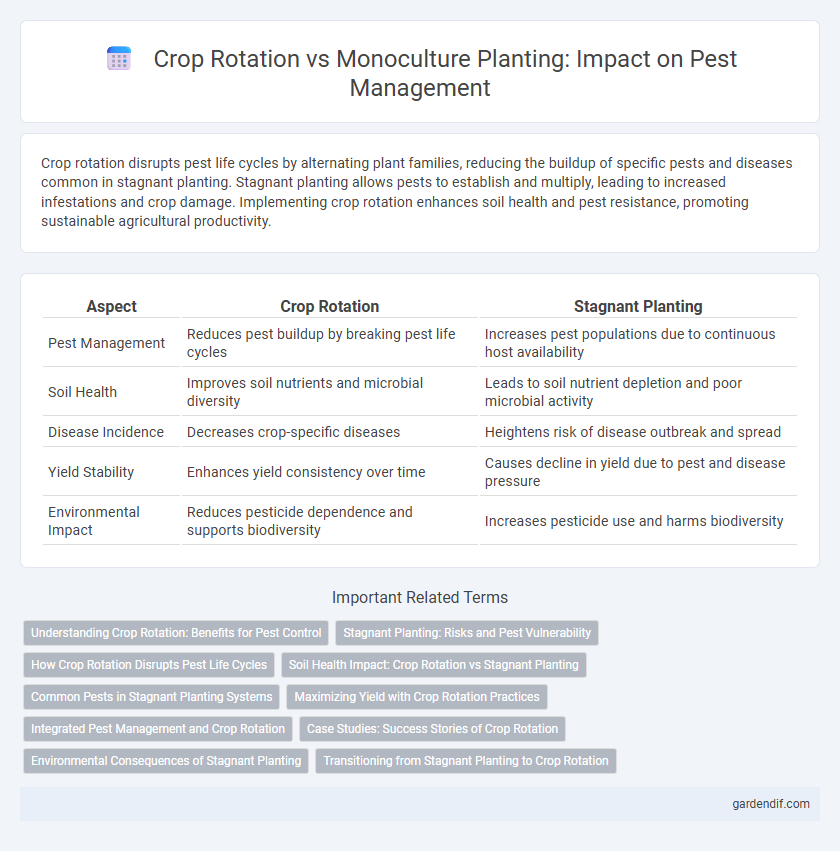
Crop rotation vs Stagnant planting Illustration
Crop rotation disrupts pest life cycles by alternating plant families, reducing the buildup of specific pests and diseases common in stagnant planting. Stagnant planting allows pests to establish and multiply, leading to increased infestations and crop damage. Implementing crop rotation enhances soil health and pest resistance, promoting sustainable agricultural productivity.
Table of Comparison
| Aspect | Crop Rotation | Stagnant Planting |
|---|---|---|
| Pest Management | Reduces pest buildup by breaking pest life cycles | Increases pest populations due to continuous host availability |
| Soil Health | Improves soil nutrients and microbial diversity | Leads to soil nutrient depletion and poor microbial activity |
| Disease Incidence | Decreases crop-specific diseases | Heightens risk of disease outbreak and spread |
| Yield Stability | Enhances yield consistency over time | Causes decline in yield due to pest and disease pressure |
| Environmental Impact | Reduces pesticide dependence and supports biodiversity | Increases pesticide use and harms biodiversity |
Understanding Crop Rotation: Benefits for Pest Control
Crop rotation disrupts pest life cycles by alternating crops, reducing the buildup of specific pest populations associated with stagnant planting. Diverse planting patterns improve soil health and enhance natural pest predator habitats, leading to decreased reliance on chemical pesticides. This practice promotes sustainable pest management by minimizing pest resistance and preventing outbreaks common in monoculture systems.
Stagnant Planting: Risks and Pest Vulnerability
Stagnant planting increases the risk of pest infestations by creating a consistent and predictable food source, which allows pest populations to thrive and multiply rapidly. Continuous cultivation of the same crop depletes soil nutrients, weakening plant defenses and making crops more susceptible to pests like aphids, nematodes, and fungal pathogens. This practice disrupts natural pest control mechanisms and often leads to higher pesticide use, increased resistance, and decreased long-term crop health.
How Crop Rotation Disrupts Pest Life Cycles
Crop rotation breaks pest life cycles by altering the host plants they depend on, reducing their ability to establish and reproduce. Different crops introduce varied root structures and pest-resistant properties, interrupting the breeding patterns of soil-dwelling and above-ground pests. This disruption lowers pest populations and decreases the likelihood of infestations compared to stagnant planting.
Soil Health Impact: Crop Rotation vs Stagnant Planting
Crop rotation enhances soil health by diversifying nutrient use and reducing pest and disease buildup, promoting microbial diversity and improving soil structure. Stagnant planting depletes specific nutrients, increases vulnerability to pests, and fosters pathogen accumulation, leading to soil degradation over time. Implementing diverse crop sequences supports sustainable soil fertility and long-term agricultural productivity.
Common Pests in Stagnant Planting Systems
Stagnant planting systems often lead to a buildup of common pests such as aphids, whiteflies, and root nematodes, which thrive due to the continuous presence of the same crop species. Crop rotation disrupts the life cycles of these pests by varying host plants, reducing pest populations and minimizing disease transmission. Implementing diverse crop sequences improves soil health and lowers the dependency on chemical pesticides for pest management.
Maximizing Yield with Crop Rotation Practices
Implementing crop rotation significantly reduces pest populations by disrupting their life cycles, leading to healthier soil and enhanced nutrient availability. Diverse planting schedules prevent the buildup of crop-specific pests and diseases common in stagnant planting systems. These practices maximize yield potential by promoting balanced soil ecology and reducing reliance on chemical pest controls.
Integrated Pest Management and Crop Rotation
Crop rotation disrupts pest life cycles by alternating susceptible crops with non-host plants, reducing pest populations without relying heavily on chemical pesticides. Integrated Pest Management (IPM) incorporates crop rotation as a fundamental strategy to enhance natural pest control, minimize resistance development, and promote soil health. Avoiding stagnant planting prevents pest buildup and supports biodiversity, making crop rotation essential for sustainable pest management in agriculture.
Case Studies: Success Stories of Crop Rotation
Case studies demonstrate that crop rotation significantly reduces pest populations by disrupting their life cycles, enhancing soil health, and minimizing the reliance on chemical pesticides. In multiple agricultural regions, farmers practicing crop rotation report up to 40% fewer pest infestations compared to farms with stagnant planting systems. These success stories highlight increased crop yields and sustainable pest management through strategic rotation of crops such as legumes, cereals, and root vegetables.
Environmental Consequences of Stagnant Planting
Stagnant planting leads to increased pest infestations due to the continuous presence of the same crop, which creates a favorable environment for pests to thrive. This practice depletes soil nutrients and reduces biodiversity, weakening natural pest control mechanisms and increasing dependence on chemical pesticides. The resulting soil degradation and chemical runoff contribute to environmental pollution and long-term ecosystem imbalance.
Transitioning from Stagnant Planting to Crop Rotation
Transitioning from stagnant planting to crop rotation significantly reduces pest populations by disrupting pest life cycles and minimizing host availability. Crop rotation improves soil health and biodiversity, creating an environment less favorable for pests compared to continuous monoculture planting. Implementing strategic crop sequences effectively lowers the risk of pest infestations and reduces dependency on chemical pesticides.
Crop rotation vs Stagnant planting Infographic

 gardendif.com
gardendif.com